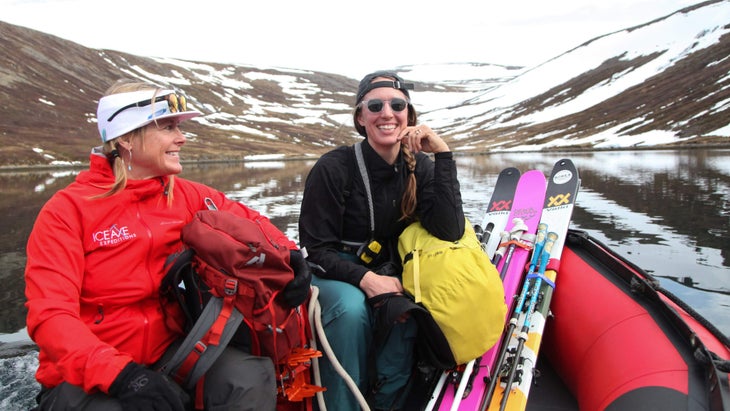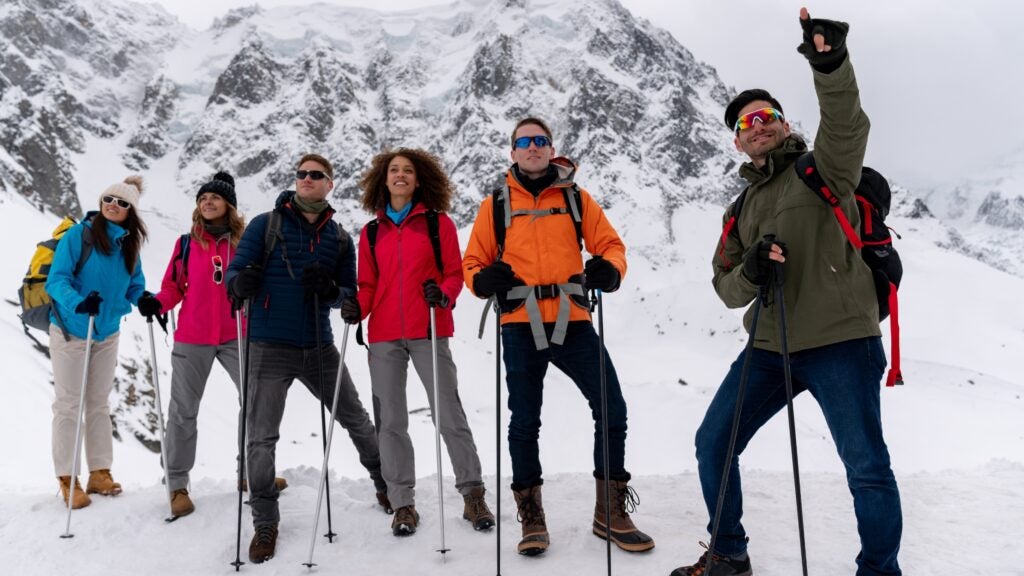No products in the cart.
Outdoor Adventure
How Much Should I Tip My Guide? We Asked Guides How Much to Give.
I was on a backcountry hut trip in British Columbia last winter, and at the end of an incredible, powder-filled week, my group of friends and I realized what most of us had forgotten: cash. Specifically, enough money to tip our two hard-working ski guides, as well as the cook, who’d been making us delicious meals morning and night, and the hut caretaker, who’d been pre-heating the sauna and shoveling the path to the outhouse.
It was a major oversight on our part. In the end, we cobbled together what cash we had and the rest of us chipped in via PayPal, a clunky fix.
In America, we know that when we go into a restaurant, it’s expected that, assuming the service is decent, you will leave your waiter a 15 to 20 percent tip on the bill. But when you go on, say, a guided backcountry ski trip or a whitewater rafting trip with a commercial outfitter or an afternoon of guided fly-fishing, the assumptions of gratuity are less clear. Are you always supposed to tip in those cases, and if so, how much?
“Guiding is very similar to the restaurant industry. It’s a service industry,” says Shane Robinson, a Seattle-based mountain guide and the founder of Graybird Guiding. He also guides for the company Alpine Ascents International. “Unfortunately, guides are probably not paid as well as they should be. So, most guides rely on those tips to make ends meet.”

Tips for outdoor guides and instructors vary wildly—some people tip a lot, some less, others don’t tip at all—and every destination is different. If you’re traveling internationally, many countries don’t have a tipping culture like the U.S.
“Tipping these days is much more common, but it’s not across the board,” says Dave Hahn, a long-time guide for RMI Expeditions who has guided on peaks like Mount Rainier and Mount Everest. “I think of a tip as a reward for a meaningful time or for someone putting themselves out there for you, not as an expectation.”
Given that guides are often the one who makes your trip or instruction stand out above the rest, we recommend always being prepared to tip. But sorting out how much to give and when to give it after a shared adventure can be awkward, confusing, and feel so hush hush, like no one’s talking openly about it.
Well, we are. We asked all the hard and awkward questions to provide these dos-and-don’ts guidelines on how to tip like a pro.
1. Do the Math
Typically, the gratuity rate for guides should be around 10 to 20 percent of the total trip cost. That means if you’re paying $500 for a day or two of guided rock climbing, an appropriate tip for your guide would be between $50 and $100.
2. Do Tip Even On Pricey Trips
Maybe you’ve just thrown down $5,000 for a Grand Canyon river trip. That’s a huge chunk of cash for a guided trip. Do you really have to tip on top of that? The answer is yes. “I sometimes find that when the cost of the trip is higher, people tend to tip less,” says Canadian guide Holly Walker, an ACMG-certified hiking and ski guide and owner of Fall Line Guides.
What helps me is to go ahead and factor in a 10 to 20 percent tip based on the total price of the trip into my initial budget to reduce the shock factor. So for that $5,000 trip, I’d tip $500 to $1,000 to be split up amongst the guides.
3. Do Prepare Ahead
Being a good tipper means planning in advance. You don’t want to get caught at the end of your trip without any cash. (Like, um, me.) Sandy Cunningham, CEO and co-founder of the adventure travel company Uncharted, advises her clients to pack a dozen or so envelopes, each filled with predetermined amounts of money and labeled for their recipient: driver, guide, cook, cleaning staff, etc. “You have your travel pouch with all the important things: passports, vaccination cards, envelopes with tip money,” Cunningham says. “That way you’re ready.”
4. Do Tip at the End of Your Trip
Some guiding services will offer a tip for the guide to be added onto your credit card purchase when you book the trip. But tipping is a token of gratitude that should be delivered at the end of your trip, based on a job well done. Typically, there’s a parting moment, when you and your guide are saying your goodbyes. That’s the best time to pass over the envelope and say thank you for the experience.
“At the end of your time, you pull the envelope out and give it to the person directly,” says Cunningham. “I will often bring my own thank you cards and write a personal note, too.”
5. Do Bring Cash
“I joke that I’ll take whatever form you’re paying in. We’re grateful for however it comes,” Shane Robinson says. But cash is king. If you can’t get cash or don’t want to travel with a wad of bills, American guides are accustomed to receiving online tips via Venmo these days. Just make sure you get their Venmo handle so you pay the right person. “It’s sometimes easier to divide up an electronic tip amongst a guide staff,” adds Hahn.
Venmo is currently only supported in the U.S., so if your guide is Canadian or from any other country, cash is the best form of payment. If you book your guide through a site like 57Hours, the app has tipping built in, and that’s a fine way to tip your guide. If you’re tipping porters, drivers, and local guides directly, cash is always preferred.
6. Do Give U.S. Dollars
Ask Walker, the Canadian guide, about preferred currency and she will say: “U.S. dollars are always OK.” So, feel free to get cash from an ATM at home before leaving the country if you don’t want to deal with picking up local currency when you arrive. “Unless it’s stipulated otherwise, people love U.S. Dollars, especially if their currency is weak,” adds Sandy Cunningham.
7. Don’t Forget About Instructional Settings
Guiding can come in many forms—including lessons from a wide range of instructors. Say your kid takes a private lesson from an instructor at a ski resort in the U.S. or you sign up for a mountain bike clinic or a running retreat. A tip is always appreciated. Again, 10 to 20 percent of the lesson price would be about right. Many guides also teach avalanche safety classes or mountaineering courses, and though tips are far less common in those situations because they’re less service oriented, the guides say they’re very grateful when people think to tip afterward. “As guides, the work is essentially the same,” Robinson says.
8. Do Remember the Rest of the Staff
Whether you’re at a backcountry hut, a wilderness lodge, or a safari camp, you might have a guide or two, as well as a cook, caretaker, or cleaning staff. At the end of your trip, plan on tipping out everybody in a service position. First, tip your guide 10 to 20 percent of the total cost. If you have multiple guides, you can tip the lead guide and they can split that up amongst the other guides. Then leave a separate tip—look for a designated tip box, or ask your guide where to leave it—to be distributed amongst the rest of the staff.
“If you’re heli-skiing, you’ve got pilots, waiters, housekeeping, bartenders, tail guides. If you’re on Kilimanjaro, you’ve got porters, people building tents, local guides,” Hahn says. “Those are times when you probably want to touch base with your guide. You can say, ‘How do I take care of the support staff?’ I don’t want to be bashful about those conversations. I consider that part of my job as your guide to make sure that local staff gets tipped properly. They’re much more dependent on those tips than I am.”
9. Do Collect Your Tips if You’re in a Group
If you’re traveling with family or a group of friends, it’s best to collect your cash into one joint gratuity. You can agree on a set amount per person or each contribute what you’re able. That way, the guide isn’t receiving stealthy handshakes with cash from a dozen different people from the same group. “Having the group collect the tip is definitely preferred and nicer for everyone,” says Walker. “Everyone can still say their goodbyes, but it’s less transactions that way.”
10. Don’t Tip in Beer
Any sign of gratitude—be it a hand-written card or a gift certificate or a nice bottle of whiskey—will be appreciated. But again, cash rules. “Buying your guide a meal or beer at the end of the trip—everyone will appreciate that. That’s nice in addition to your tip,” Hahn says. “My point is anything is nice. If someone had a really good trip and credits you with it and expresses that, they don’t always have to say that in money.”
11. Do Tip Even If You Didn’t Summit
So, you paid for a guided trip and for one reason or another, things didn’t go as planned. Like all adventures in the outdoors, final outcomes can be unpredictable. “Nobody should have to pay for service that was subpar,” Cunningham says. If your guide really let you down, factor that into your tip.
But if you didn’t make it to the summit, that doesn’t mean your guide didn’t work hard. “Sometimes good guiding means saying no,” Hahn says. “There’s this perception that you didn’t get us to the top of the mountain, so perhaps you didn’t work as hard as you might have. But obviously, on those days where it’s avalanche conditions or storms or something happened where you had the good sense to not get anyone hurt, that’s still hard work.”
12. Don’t Be Afraid to Ask Questions
Gratuity in general has so many nuances, especially so in the outdoor world. Don’t be afraid to ask for help. “Before you go, check with the operation that you’re booking through if you have any questions about tipping,” Hahn says. Outfitters these days will often provide an exact number or a range of what to consider tipping.
But maybe don’t ask your guide out right what you should pay them as a tip: That exact number is still up to you. “I guided a family for a week and as we were saying our goodbyes, they said, ‘If you were us, how much would you tip you?’” Walker recalls. “It felt very awkward to ask me that directly. I told them, ‘I would tip a percentage that I thought was appropriate.’”
The bottom line is, be prepared to tip. Guiding is hard and often low-pay work, and gratuities are always appreciated.
Outside Correspondent Megan Michelson is an avid traveler who has used many guides on her adventures around the world.
Source link

